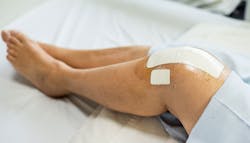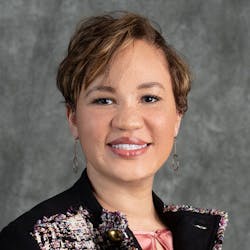Wound healing in 2022 is as complex and complicated as ever.
Managing and treating them correctly in order to ensure proper recovery continues to plague both patient and physician.
There are endless factors that go into healing a wound, and so much of it derives from the many unique particulars of that patient.
“You can’t just look at the hole in the patient, you have to look at the whole patient. Wound healing is an incredibly complex biological process, and we probably know about 60% of how we heal. Most physicians in the wound healing space have a lack of education and therefore understanding of its many aspects,” he said.
This epidemic is embedded deep within our culture; it’s an unhealthy lifestyle that breeds diabetes, and in turn, many chronic wounds.
Regulski continues, “the inflammatory pathways of diabetes are instigated by obesity, and we’re an obese country; we eat too much, drink too much, smoke too much, and don’t exercise enough. Two thirds of adults are obese. One half of all children. Obesity instigates Type II diabetes and is the underlying key to 13 cancers and 236 chronic diseases. So, if we got people to exercise and to eat better, we can probably get rid of half the chronic disease, which is staggering.”
A complex industry
The wound care industry in 2022 is as vast and complex as ever, with the ways and means of treating and tending wounds as variant as the patients who possess them.
The need for quality products and technologies in wound care is only increasing. The aging population, the prevalence of diabetes and cancers, and the wide range of autoimmune disorders combine to create a billion-dollar marketplace.
In such a competitive industry that’s overflowing with endless types of bandages, dressings, and other advanced measures, how does a company stand apart from the crowd?
“We recognize that many patients struggle with poor quality of life due to their wounds. And on the other end of the spectrum, caregivers increasingly lack the time and tools needed to deliver quality wound care. At Mölnlycke, we’re committed to addressing some of the most persistent, pervasive, and costly issues associated with chronic and advanced wound care,” Huguely said.
Thirty years ago, Mölnlycke introduced its Safetec technology; these adhesives have been clinically proven to decrease pain to the patient as well lessen trauma to their wound.
“Our entire wound care product line is second to none and so much of that differentiation is due to our Safetac technology, which is less traumatic to the skin and the wound area than other dressings. That technology is integral to most of our dressing offerings,” said Huguely.
Mölnlycke’s specialized wound dressings include Mepilex and Mepitel, which are designed especially for the treatment of ulcers in the feet and legs.
Huguely continued, “the work we do goes beyond just a dressing – and I think that’s why product lines like Mepilex have become so trusted and recognized over time. They deliver better patient experiences with less pain during dressing changes, which promotes efficient healing, and helps minimize the risk of complications.
“Additionally, we have the Mepitel line, which for patients with burns, has helped not add secondary injury to the wound. This also allows for undisturbed wound healing and comes in many sizes that give clinicians more options.”
Dressed to live
Choosing the appropriate wound dressing is vital to proper healing. In fact, one of the major problems in wound care today is that wounds are not dressed to live, aka, promote healing.
Fortunately, companies such as Medline, a distributor of medical supplies, continue to develop transformative new products and technologies in wound healing.
According to Barba, “a common challenge is managing pain from uncomfortable dressing changes in burn patients. This not only stresses the patient and the family, but it can also delay their discharge. PluroGel can lead to less painful dressing changes, allowing patients to achieve a better outcome while healing at home.”
Barba described how Medline’s IoPlex foam dressing has used a completely new approach, in this case, iodine, to effectively treat significantly recalcitrant wounds.
“It (Ioplex) is the only foam dressing with controlled release iodine. A recently published in-vitro study showed iodine is more effective than other topical agents for managing chronic biofilm infections. This allows healthcare workers to treat significantly recalcitrant wounds effectively, that before could have been stalled.”
Another company that is making their mark in the development of advanced wound care products is Dynarex.
“At Dynarex we provide advanced wound care solutions with a wide range of specialized dressings. Some dressings are highly absorbent, multi-layered, and medicated based on the specific wound needs. Our dressings are specialized in keeping wounds moist, as well as absorbing and managing exudates. They also help facilitate the healing process.”
Losing our footing
With the skyrocketing rates of diabetes (both nationally and internationally), the attention on diabetic foot ulcers has, and will continue to, heighten immeasurably. Close to 25% of diabetes patients will develop wounds in their lower extremities1; more than 10% of these wounds result in amputations.2
When one thinks of amputations, they may think of limbs being lopped off in the midst of The Civil War, because, at that time, we simply did not have the means or methods to save them. It’s estimated that in that horrific 4-year span, approximately 60,000 soldiers underwent amputations.3
According to Regulski, diabetic foot wounds result in 80,000 amputations in the United Stats every single year. And, during the COVID-19 pandemic, the rate of amputations are 11 times greater than they were previously.
He continued, “The cost of treating a diabetic foot ulcer can range anywhere from $9,000 to $27,000. If you end up with a leg amputation, your chances of surviving for 5 years are less than 30%. The existential threat is that here in the U.S., we have about 95 million prediabetics; 5 to 10% of them are going to convert to diabetes. There are 37 million diabetics currently in this country, and about 2 million foot ulcers a year. Every 30 seconds, a limb is amputated due to diabetes (in this country).”
It seems we don’t understand the the degree to which we are responsible for our own wound management, and healing progression. Such is the case where wounds arise in our extremities as the result of diabetes.
According to Regulski, “wounds get stuck in the inflammatory phase. They can’t progress on and there’s multiple factors, such as poor nutrition, and low levels of Vitamin C, D, and protein; these all need to be checked and supplemented.
Also, when patients have a diabetic foot ulcer, they need proper off-loading to rest the wound and protect it from shearing and pressure forces; if not, it will be very hard to heal. In addition to the pressure, other factors preventing proper healing include smoking, poor sugar control, peripheral vascular disease, acute infection, pathologic poor edema and exudate management.”
Perhaps just (if not more) startling is that the negative circumstances of wounds can often be attributed to the doctors that are trying to treat them. As Regulski stated, “I’ve seen people that have come in and they’ve had four or five different things just applied to the wound, or they’d had eight or nine different antibiotics prescribed. I treat 10,000 chronic wounds a year and I’ve probably given out antibiotic prescriptions for 4 of them.”
Numbers don’t lie
According to the CDC, 1.6 million people in the United States had diabetes in 1999; in 2015, that number increased to 23.4 million.4
According to Regulski, “by the year 2030, one in every seven to eight people are going to be diabetic. When we look at people that have a diabetic foot ulceration, that alone carries a 50% mortality rate, which is higher than all cancers, with the exception of pancreatic.5 In 2019, 4.2 million people died from diabetes and its related complications, and we spent $760 billion on its treatment.6
The numbers are inarguable.
For those of us working in healthcare, it is our duty to be constantly immersing ourselves in information. Regulski asserted, “I study and read about wound healing everyday. If I don’t know something, I research it, I ask questions. I am not afraid to say that I don’t know. I have been in practice for 18 years and can tell you that there are so many physicians who don’t do that.”
The innumerable factors and strategies vary between every patient and every wound. Thus, it could not be more vital to take a holistic appoach to wound healing. As Regulski said, its’s a team effort.
“Wounds are a multisystemic issue that require a multifactorial approach.”
References
1. Bharara M, Mills JL, Suresh K, Rilo HL, Armstrong DG. Diabetes and landmine-related amputations: a call to arms to save limbs. Int Wound J. 2009;6(1):2-3.
2. Bosse MJ, MacKenzie EJ, Kellam JF, Burgess AR, Webb LX, Swiontkowski MF, Sanders RW, Jones AL, McAndrew MP, Patterson BM, McCarthy ML, Travison TG, Castillo RC. An analysis of outcomes of reconstruction or amputation after leg-threatening injuries. N Engl J Med. 2002 Dec 12;347(24):1924-31.
3. American Battlefield Trust. Amputations and the Civil War. https://www.battlefields.org/learn/articles/amputations-and-civil-war. Accessed May 16, 2022.
4. https://www.cdc.gov/. Accessed May 16, 2022.
5. Rowley WR, Bezold C, Arikan Y, Byrne E, Krohe S. Diabetes 2030: Insights from Yesterday, Today, and Future Trends. Popul Health Manag. 2017;20(1):6-12. doi:10.1089/pop.2015.0181.
6. Williams R, Karuranga S, Malanda B, Saeedi P, Basit A, Besançon S, Bommer C, Esteghamati A, Ogurtsova K, Zhang P, Colagiuri S. Global and regional estimates and projections of diabetes-related health expenditure: Results from the International Diabetes Federation Diabetes Atlas, 9th edition. Diabetes Res Clin Pract. 2020 Apr;162:108072. doi: 10.1016/j.diabres.2020.108072. Epub 2020 Feb 13. PMID: 32061820.
About the Author
Scott Tomko
Managing Editor
Scott Tomko was previously Managing Editor for Healthcare Purchasing News.





